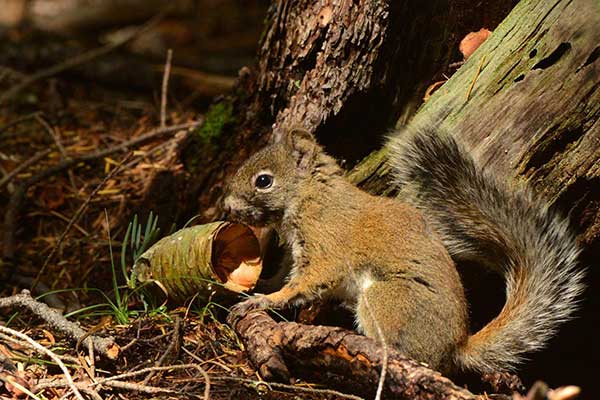Wildfire caused significant habitat loss, dispersed some red squirrels
PHOENIX — One year after their habitat was nearly wiped out by the 2017 Frye Fire in the Pinaleño Mountains of southeastern Arizona, an annual survey of the endangered Mt. Graham red squirrel shows a notable increase in their population.
The annual survey, conducted jointly by the Arizona Game and Fish Department (AZGFD), Coronado National Forest, U.S. Fish and Wildlife Service, Arizona Center for Nature Conservation – Phoenix Zoo, and the University of Arizona, resulted in a minimum estimate of 67 squirrels – a 91-percent increase from the 35 recorded in 2017, when populations were severely impacted by the Frye Fire.
In 2016, there were an estimated 252 squirrels. The Mount Graham red squirrel population peaked at about 550 animals in the late 1990s, but typically ranges between 200 and 300 individuals.
“The Mt. Graham red squirrel has faced some significant, daunting challenges since their habitat was severely damaged by the Frye Fire,” said Tim Snow, AZGFD terrestrial wildlife specialist. “The data suggests that while the fire was devastating to red squirrel habitat and their overall population, several likely fled the area to avoid the ensuing wildfire. This is truly a resilient species, but much work must be done to help conserve and protect the species to ensure its continued recovery.”
This annual red squirrel survey consisted of visiting all known middens, which are areas where red squirrels store or cache their cones. Activity at these middens is used to estimate the population size.
“In the wake of the Frye Fire, the squirrels have taught us a great deal about how they respond to altered and even devastated habitat,” said Jeff Humphrey, FWS’s Arizona Ecological Services field supervisor. “The survey results are helping us focus our redoubled efforts to restore habitat and squirrel numbers.”
”We appreciate the continued cooperative efforts on behalf of the squirrels,” said Coronado National Forest Supervisor Kerwin Dewberry.
The subspecies was listed as endangered in 1987. Mount Graham red squirrels live only in the upper elevation conifer forests of the Pinaleño Mountains and feed primarily on conifer seeds. This subspecies is highly territorial and has lower reproductive rates than red squirrels in other locations.
Long-term impacts to Mount Graham red squirrels and their habitat include high-intensity wildfires and associated insect infestations, possible competition with non-native Abert’s squirrels and poor cone crops caused by drought, all of which influence population size.
Biologists continue to explore new methods to conserve the species, including continued squirrel research, developing long-term forest management strategies across the fire-impacted landscape such as re-seeding and planting coniferous trees, and a managed care breeding program.









